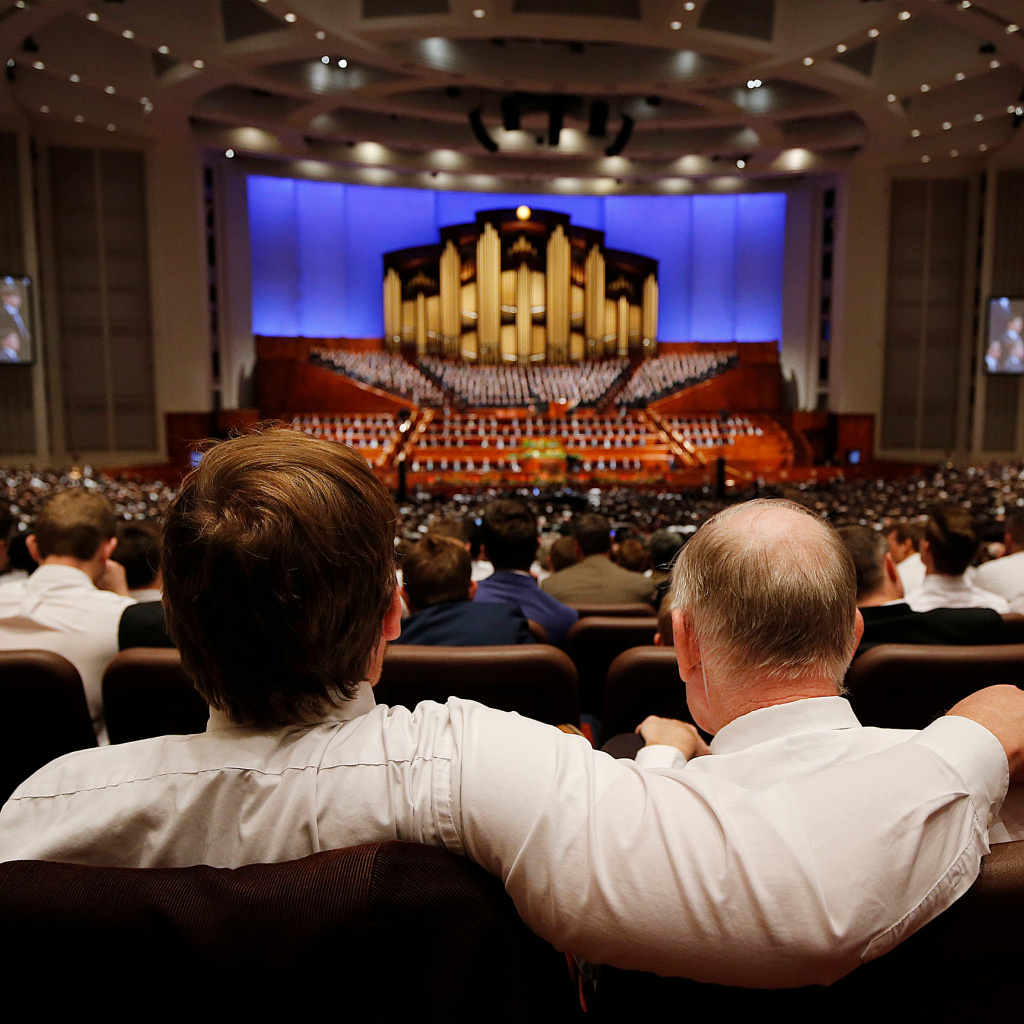The year is 1886. Reporters in the bustling newsroom of The New York Times are fervently typing stories of the day. Amidst the clanking of keys and lively conversations, a particular topic gains prominence: ‘The Mormon Question,’ a riveting issue that’s been driving national interest.
Several states away, Utah’s quiet settlements tell a contrasting tale. Influenced by the press-driven moral panic against them and their faith, recently enacted federal laws are starting to take effect. Property held by The Church of Jesus Christ of Latter-day Saints is confiscated, its leaders driven into hiding, and its men are imprisoned.
The sensationalistic coverage a continent away caused real harm to Latter-day Saints.
This stereotype of Latter-day Saints as dangerous and sexually deviant continues to linger. One might hope that, over time, this style of sensational journalism would have diminished, and national outlets would have recognized Latter-day Saints as a part of the diverse spectrum of American faith. But this bias bares its head in press coverage even today.
On May 14, 2023, CBS’s “60 Minutes” aired a story highlighting allegations of financial misconduct within the Church, reviving old unsubstantiated allegations, repackaged in a sensational narrative, providing an enticing spectacle for its millions of viewers.
A History of Media Gawking
From its inception in the early 19th century, The Church of Jesus Christ of Latter-day Saints faced intense scrutiny and ridicule from the mainstream press. Founder Joseph Smith’s revelation of the Book of Mormon was dismissed as a fraudulent ‘Gold Bible’ scheme, and his visionary claims were met with skepticism. This hostile media portrayal seeded public suspicion toward the Church, setting a precedent for future depictions. The sensationalistic coverage a continent away caused real harm.
This trend of sensationalist coverage persisted into the 20th and 21st centuries. A notable instance is the Mark Hofmann forgery scandal in the 1980s, where the media fixated on the Church’s supposed gullibility, overshadowing Hofmann’s crimes. More recently, unverified rumors about sexual practices at Brigham Young University (BYU) were uncritically reported in a major national publication, painting Latter-day Saints as sexual deviants in a manner normally reserved for tabloids.
The media has also disproportionately emphasized the religious affiliation of Latter-day Saints involved in criminal cases. In 2019, when Steven Murdock, a local high councilor, was found guilty of voyeurism, his religious affiliation was highlighted in almost all coverage, even though no other article written about a voyeurism case mentioned the religion of the perpetrator for at least eighteen months prior. Even as victims, Latter-day Saints’ faith is gratuitously discussed, such as an Associated Press report on a tragic cartel ambush involving members of an off-shoot sect, that still managed to name-drop the Church in its title. Or perhaps even more galling is the upcoming “comedy” about the Latter-day Saint missionary who was kidnapped and repeatedly raped. These instances underscore the media’s enduring fascination with the Church and its supposed practices, leading to the sensationalism that continues to manifest today.
What is the Baseline?
What should The Church of Jesus Christ of Latter-day Saints expect in terms of media scrutiny and respect? Accountability for misconduct or harmful practices is a given for any religious or non-profit organization. However, —standards often missed in the sensationalized coverage the Church receives.
Take, for example, media portrayals of Latter-day Saint teachings on sexuality. Stories often depict Latter-day Saints as prudish, repressed, or deviant. In contrast, teachings on sexuality in other religious groups, like Catholicism’s celibacy or Islam’s modesty laws, are typically presented with more nuance and less sensationalism.
A stark discrepancy exists in how media treats controversies within various religious groups. Consider the sexual abuse scandals within the Southern Baptist Convention—systemic issues that receive comparable media attention to isolated incidents involving Latter-day Saints outside leadership. This disparity amplifies minor incidents while often romanticizing unique practices of other religious groups, such as the Amish’s rejection of modern technology or Jainism’s asceticism.
Media coverage often respects doctrines and rituals of other religions more than those of the Latter-day Saints. Islamic rituals during Eid al-Fitr or Hinduism’s Kumbh Mela, for instance, are typically portrayed with reverence, avoiding any portrayal of these practices as strange or outlandish—courtesy Latter-day Saints can only wish for when it comes to their temple endowments.
The media’s role in scrutinizing powerful organizations is essential, but it can’t be assumed that their critical focus is always warranted. Existing biases that amplify a group’s otherness can prove to be a major motivation in how much coverage exists and how that coverage is framed.
Where 60 Minutes Fails
In a world where money now often parallels sexuality as taboo, it’s hardly surprising that The Church of Jesus Christ of Latter-day Saints’ finances have become the new horizon for media gawking. A recent “60 Minutes” story explored claims made by David A. Nielsen, a former church investment manager. Nielsen’s allegations, known for three years, were steeped in esoteric anti-Mormon references, like tapirs, largely overlooked by the media. After years of his claims stagnating, Nielsen’s “60 Minutes” interview added nothing new, mostly expressing his disagreement with the Church’s approach to financial management. His only claim of substance that the Church should lose its non-profit status for the way it manages its finances has been thoroughly and repeatedly debunked.
Some have taken the “60 Minutes” report seriously and responded in kind. But frankly, unserious journalism does not warrant a serious response. “60 Minutes” did not press Nielsen on how many years’ savings he believed the Church should be allowed to have. They did not ask Nielsen why he believed certain investments were problematic. They did not ask him how he would responsibly scale up long-term humanitarian aid to avoid the detrimental check and dump practice. They didn’t even push him on his internal inconsistencies. They gave him a platform to say he could have done a better job than his old bosses, without even pushing him to explain how. If that constitutes news, I have a certain grocery store chain I worked at when I was 17 that could use a real talking to.
The Church does maintain financial privacy, aligning with best practices, such as using shell companies for real estate development. These privacy practices are in line with the example of Jesus Christ. And the Church does invest wisely in line with Jesus’ teachings. And yes, the Church does have $45 Billion (less than Harvard) even though the Church runs five colleges and universities, not to mention a 17-million member church. “60 Minutes” also couldn’t be bothered to mention, that even if the Church of Jesus Christ did have the spending requirements of non-religious non-profits, they would still be spending more than enough to meet federal requirements. The reality is simply unremarkable. But this unremarkable reality simply doesn’t draw the attention “60 Minutes” hoped for.
So much like The New York Times gawked at the outsiders for their weird sexual practices, CBS now gawks at the outsiders for their weird financial practices. In a consumeristic, spend-first world, the only people who get a pass are glitzy organizations like Harvard or Gates Foundation. But Latter-day Saints having money? Those polygamists in Utah? That’s weird. We don’t trust them. So they gawk and develop thin pretexts to justify doing so. In the case of “60 Minutes,” they don’t even go to the courtesy of crafting a pretext, but regurgitate old and debunked claims, just because it’s sweeps season, I assume.
Church leaders certainly make mistakes, including in the financial arena. The most notable recent example was a minor SEC fine for a reporting error, which the Church acknowledged and rectified. And journalists should report on that in its appropriate context. But evidently the actual news wasn’t enough.
While financial accountability is crucial for all organizations, including religious institutions, justified coverage requires new revelations or substantiated accusations of wrongdoing. Absent these, just like the “Mormon Question” before it, “60 Minutes” charged ahead anyway.
Why Sensationalized Coverage
Several contributing factors emerge when scrutinizing media sensationalism surrounding The Church of Jesus Christ of Latter-day Saints, which include societal misconceptions, historical anti-Latter-day Saint sentiment, and the lucrative nature of sensationalism in the media industry.
It’s important to recognize that the Church isn’t unique in receiving such sensationalist media attention. Certain topics inherently attract readers, and the term “Mormon” in a headline, akin to “Kim Kardashian” or “Nick Cannon,” does generate more pageviews. The objective here is not merely to chastise media outlets for their sensationalist formulas, but rather to identify the discriminatory factors that have put Latter-day Saints in this media predicament.
The lingering anti-Latter-day Saint sentiment also likely contributes to this issue. The Church, since its inception, has encountered intense scrutiny and opposition. These historical biases which spring from the unfamiliarity and misconceptions of the Church play a significant role in this sensationalism. The Church’s distinctive doctrines, its relatively recent origin compared to other major religions, and its position as an American-founded religion may give journalists the implicit latitude to undermine Latter-day Saint faith in a way they would never consider for other world religions.
Furthermore, the Church’s stringent moral and sexual codes often put it in conflict with broader societal norms, potentially giving journalists justification to take shortcuts if it could help undermine a church they view as problematic.
In essence, sensationalism is lucrative; it magnetizes clicks, elevates ratings, and boosts ad revenue. But the reason the Church of Jesus Christ gets caught in the sensationalistic cross hairs in a way few other religions do springs from lingering biases.
Impact of Sensationalism
In attempting to grab attention, sensationalist media coverage often reduces complex realities to simple, easily digestible narratives. However, these narratives can distort the truth, perpetuating stereotypes and misconceptions about the Church and its adherents. They may frame the Church as secretive, its practices as strange, or its members as blind followers. What should by any objective measure be a largely positive story of a frontier church that has saved responsibly in line with Jesus Christ’s teachings and can now donate more than one billion dollars a year in humanitarian aid is still somehow twisted into a negative story.
Sensationalism in media, although commercially beneficial, can cause significant harm to those targeted by such coverage. The Church of Jesus Christ of Latter-day Saints and its followers are among those adversely affected, facing resultant prejudice, misunderstanding, and potential discrimination. Specifically, such portrayals can have real consequences for Latter-day Saints. Recent studies indicate that public opinion about the Church is lower than for any other faith in the U.S. Numerous Church members have reported experiences of suspicion, bias, or outright hostility due to these pervasive narratives. The media should provide coverage that is fair, accurate, and contextual.
The Persecution Complex
The phrase “persecution complex” is often flippantly thrown at Latter-day Saints who express concerns about media bias, misrepresentation, or general disrespect towards their faith. This dismissive label, frequently used by individuals from marginalized groups who wish to maintain social standing within high-status groups, insinuates that any protest of ill-treatment is merely an overreaction or an effort to play the victim.
This dynamic, wherein certain individuals are offered conditional acceptance or privilege on the expectation that they dissociate from their group, endorse dominant values, and possibly even criticize their own group, plays out often and appears to be in play here. The charge of a “persecution complex” allows these individuals to signal their loyalty to those in power, thereby safeguarding their privileged position.
This “persecution complex” accusation, however, neglects the substantial evidence of bias against the Church and its followers. Numerous academic studies reveal that Latter-day Saints encounter tangible prejudice in personal dealings and media depictions. For instance, a Pew Research Center study in 2012 reported that Latter-day Saints face greater discrimination than many other religious groups in the US.
It’s apparent that the narrative concerning The Church of Jesus Christ of Latter-day Saints is frequently more influenced by media sensationalism than by the Church’s own actions or teachings, with the recent ’60 Minutes’ report serving as a clear case in point.
In the end, the task of countering these distortions falls to all of us. As consumers of news, we must cultivate an informed skepticism, seek out multiple sources, and question narratives that seem designed to shock or titillate. Our collective ability to rise to the challenge will say a lot about us, and perhaps not so much about the subjects of the next sensationalized news story.
















